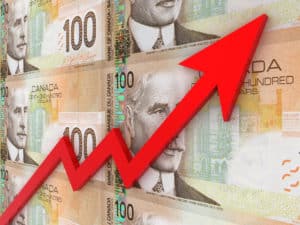The capital gain exemption rate is one of the biggest tax breaks Canadian investors can claim. Sometimes referred to as the “capital gains tax credit,” it is the percentage of a capital gain that is tax-exempt. Historically, the exemption rate was 50%.
This year, matters got more complicated. In the 2024 budget, the Federal Government hiked the capital gains inclusion rate to 67.5% for capital gains above $250,000. Although most Canadians won’t have enough capital gains in a given year to be affected by the higher inclusion rate, the move toward higher capital gains taxes raises an important question.
Will the capital gains tax credit eventually disappear?
The Federal Government has been running large deficits for many years now. In 2020, in particular, the country ran a historic $327 billion deficit — dwarfing any before or since. Although the deficit has come down since then, the COVID-era borrowing binge left a legacy of higher Federal debt. Such debt results in interest expenses; a portion of every taxpayer’s tax bill goes to paying such expenses, leaving less money for services.
The logical thing for the government to do in a situation like this is to raise taxes. Indeed, it did so with the increase in tax rates on large capital gains. The Federal debt is still nowhere near being repaid, so it’s worth asking whether the capital gains tax credit will gradually dwindle over time as the government seeks new revenue sources.
Other countries’ experiences
If other countries’ policies are any indication, then the Canadian government could raise capital tax rates beyond today’s level. Several countries have higher capital gains tax rates than Canada. Denmark has a maximum capital gains tax rate of 42%, Norway has a 37.8% rate, and France has a 34% rate. The maximum possible capital gains tax in Canada this year is 33.3%. That is a 50% maximum marginal tax rate (in Ontario) on 66.7% of an investor’s income.
Now, this is simplifying a little because the first $250,000 of a capital gain is taxed at a 50% inclusion rate. The maximum tax on that first $250,000 is 25%. However, an extremely wealthy Canadian could pay a capital gains tax approaching 33.3%. That’s still below the top rates in Denmark, Norway, and France. So, there is an international precedent for Canada’s capital gains tax eventually going higher.
Total elimination of the capital gains tax credit unlikely
The flipside of the examples above is that none of them are above 50%. That’s what Canada’s maximum capital gains tax rate would be if the capital gains tax credit were completely eliminated. So, it appears unlikely that the Federal Government will completely get rid of the capital gains tax credit.
What to do about capital gains taxes
If you’re concerned about capital gains taxes eating away at your returns, one thing you can do is exit your investments in stages rather than all at once.
Let’s imagine you had a $1,000,000 position in Fortis (TSX:FTS) stock. Fortis is a dividend stock with a 3.99% yield. It has experienced significant capital gains over the years as well. So, it’s a good example to work with here.
Now, if you bought your Fortis shares near the end of 2010, you’d be sitting on a 100% capital gain. So, 50% of your return (ignoring dividends) would be taxable. If you sold the entire position in a single year, you’d have a $500,000 gain, of which $333,500 would be taxable.
In many provinces, the highest tax bracket kicks in at $250,000 in income. That bracket is typically 50% in combined Federal/Provincial taxes. So, $83,500 of your gain would be taxed at a whopping 33.3% if you had no employment income. If you had $250,000 in employment income, the entire $333,500 would be taxed at 33.3%, giving you a truly colossal tax bill.
If, however, you sold off your Fortis shares in $50,000 chunks over the course of your retirement, you’d stay below the $250,000 threshold and keep the 50% inclusion rate. So you’d be taxed on a smaller percentage of your gains and avoid pushing yourself into a higher tax bracket. Talk about a win-win situation.








